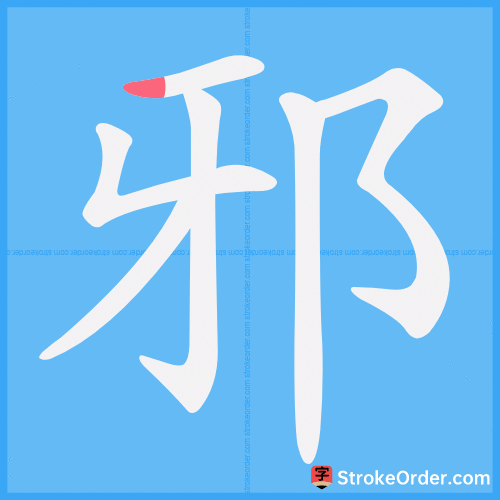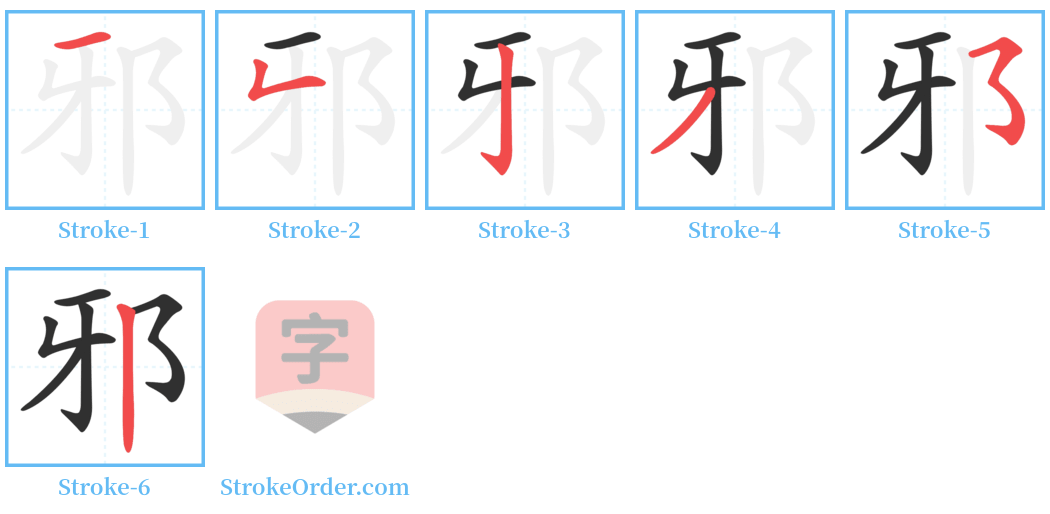邪 Stroke Order
Animated Stroke Order of 邪

Stroke Order Diagrams for 邪

Step-by-Step Handwriting Guide for 邪

Learn to Write Chinese Characters with Video Tutorials
Watch the video of writing the Chinese character "邪", learn the correct stroke order (笔顺) of the character "邪", and master the standard way of writing the character "邪".
Free Printable Handwriting Practice with Stroke Order: 邪
Printable Writing Practice Worksheet of "邪" in Portrait Orientation (Tian Zi Ge)

Printable Writing Practice Worksheet of "邪" in Landscape Orientation (Tian Zi Ge)

Information of 邪
Pinyin
xié、 yé、 yá、 yú、 xú
Radical
阝
Strokes
6 strokes
Usage
★★★★★
Definition
demonical / iniquitous / nefarious
邪 [xié]
形
1. 不正当,不正派:evil; malevolent.
例:邪恶(evil); 邪念(evil thought); 邪说(slanderous speech)。
2. 异常,妖异怪诞:heretical; bizarre.
例:邪魔(evil spirits); 邪术(witchcraft)。
名
1. 品行不正的人:crafty and evil person.
例:邪丑(evil and ugly person)。
2. 中医指邪气:pathogenic factor; an opposing force to the body's proper energy, referring to various pathogenic factors and their pathological damage.
例:寒邪(cold pathogenic factor); 风邪(wind pathogenic factor);灸刺和药逐去邪(moxibustion and medicine to expel evils)。
3. 妖异怪戾之事或迷信人所称的神怪、妖异:demon; associations with strange and supernatural phenomena.
例:中邪(possessed by demons); 邪魅(evil charm)。
4. 另见 yé.
邪 [yé]
1. 同“莫邪” (mòyé).
2. 古同疑问词“耶”: used as an interrogative word.
3. 另见 xié.
古同“玡”,琅玡山:an ancient term referring to a geographical location.
上述[一]的另一种读音。
古同“徐”,缓慢:slowly.
例:诗经.邶风.北风:「其虚其邪,既亟只且。」这句话的解释指的是当时的社会状态比较缓慢和宽和。
副词:慢慢的,通「徐」。
古同“餘”:余分。
名
剩余:remaining; surplus.
例:史记卷二六:「归邪于终,事则不悖。」
名词:剩余。
例:史记卷二六:「归邪于终,事则不悖。」
strengthening the body resistance to eliminate pathogenic factors / strengthening body resistance and eliminating evil
evil influence / unhealthy trend / pathogeny (cause of disease) in TCM / as opposed to vital energy 正氣|正气[zheng4 qi4]
Input Method for 邪
Pinyin
xie2
Wubi
ahtb
Cangjie
mhnl
Zhengma
hiy
Four Corner
77227
Unicode
U+90aa
Same Pronunciation Characters